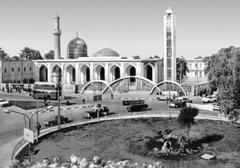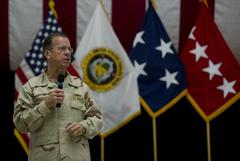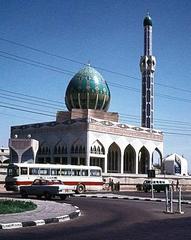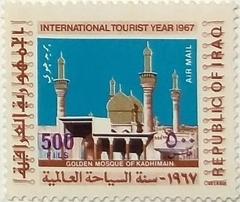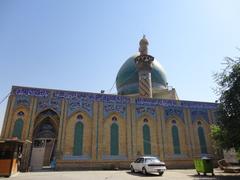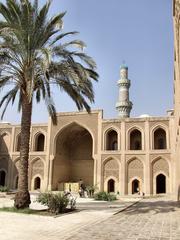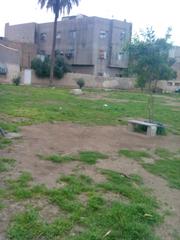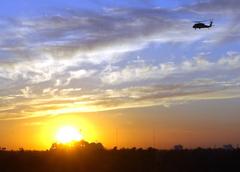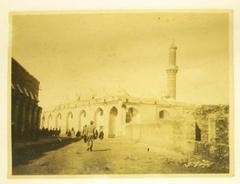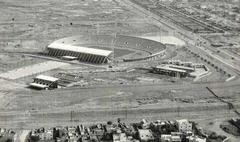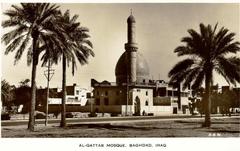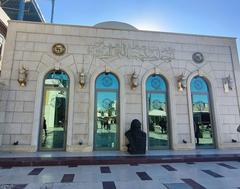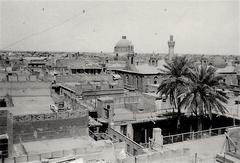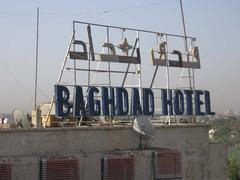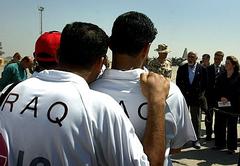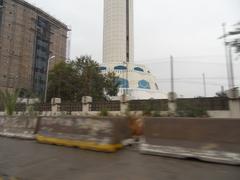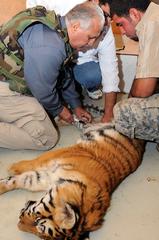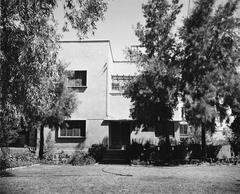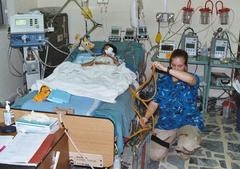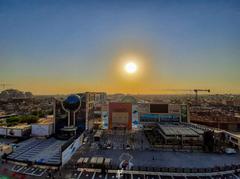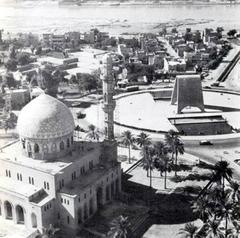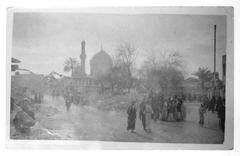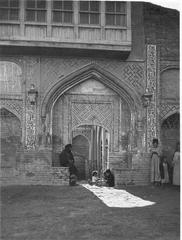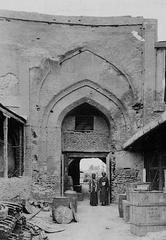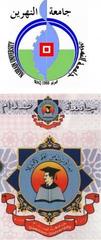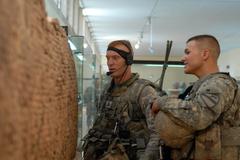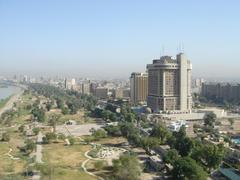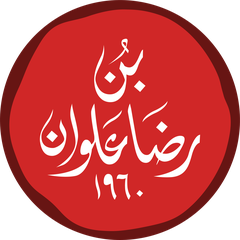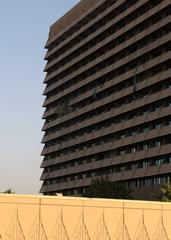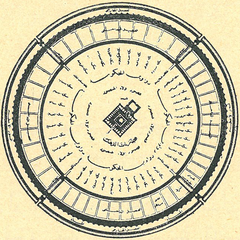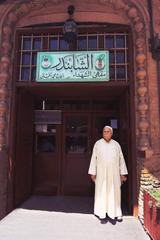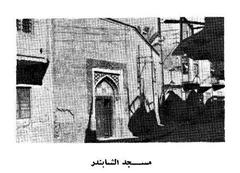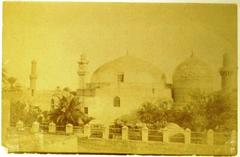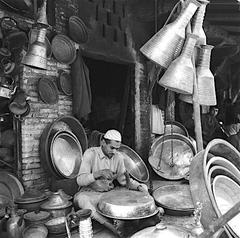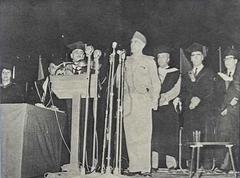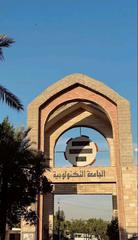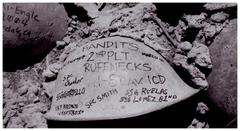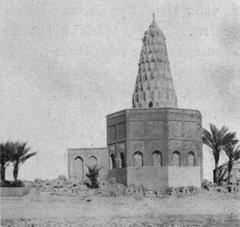Umm Al-Qura Mosque: Visiting Hours, Tickets, and Historical Significance in Baghdad, Iraq
Date: 14/06/2025
Introduction: The Legacy of Umm Al-Qura Mosque
Umm Al-Qura Mosque stands as a monumental symbol of Baghdad, reflecting Iraq’s intricate history, political shifts, and enduring faith. Originally built under Saddam Hussein’s regime and inaugurated in 2001, it was initially named Umm al-Ma’arik (“Mother of All Battles”) Mosque to commemorate Iraq’s resilience after the Gulf War. The mosque’s architecture uniquely weaves together political symbolism—such as minarets shaped like Scud missiles and Kalashnikov barrels—with traditional Islamic motifs, making it one of Iraq’s most striking and historically significant landmarks. Following the fall of Saddam Hussein in 2003, the mosque was renamed Umm Al-Qura (“Mother of All Cities”), marking a transition from political propaganda to an emphasis on Islamic unity and reconciliation (Christian Science Monitor; Al Jazeera; e-a-a.com).
Today, the mosque serves as a dynamic center for Sunni Islamic worship, education, and interfaith dialogue. Its massive blue-and-white dome, intricate calligraphy, and expansive prayer halls continue to attract worshippers, history enthusiasts, and architecture lovers alike. This guide provides a comprehensive overview of Umm Al-Qura Mosque’s origins, architectural marvels, political and cultural significance, as well as practical information for visitors—including visiting hours, ticketing, dress code, accessibility, and travel tips (Mosqpedia; Visit Iraq Now).
Table of Contents
- Introduction
- Historical Origins and Construction
- Symbolic and Architectural Features
- Political Role and Post-2003 Transformation
- The Mosque’s Contemporary Role
- Visiting Information: Hours, Tickets, and Etiquette
- Accessibility, Facilities, and Travel Tips
- Nearby Attractions and Photographic Highlights
- Frequently Asked Questions (FAQ)
- Summary and Final Tips
- References
Historical Origins and Construction
The Umm Al-Qura Mosque—originally Umm al-Ma’arik Mosque—was commissioned by Saddam Hussein, with its foundation stone laid on his birthday, April 28, 1998 (Mosqpedia; Beautiful Mosque). Construction was completed by April 28, 2001, marking the tenth anniversary of the Gulf War (Amusing Planet). Despite Iraq facing international sanctions and economic hardship, the mosque’s estimated cost between $7.5 and $10 million underscored its intended political prominence (Christian Science Monitor).
Symbolic and Architectural Features
Umm Al-Qura Mosque’s design is saturated with symbolism. Its four outer minarets resemble Scud missiles, while four inner minarets evoke Kalashnikov barrels—each 43 meters tall, representing the duration of the Gulf War. The central dome sits atop a reflecting pool shaped like the Arab world and features a 25-foot mosaic of Saddam’s thumbprint and initials (Amusing Planet). The mosque also houses a Quran reportedly written in Saddam’s blood, a testament to the regime’s cult of personality.
The prayer hall accommodates up to 5,000 worshippers, adorned with Quranic inscriptions and intricate geometric patterns (ArchNet). The mosque’s gates, courtyards, and domes blend traditional Islamic artistry with monumental modernism (e-a-a.com).
Political Role and Post-2003 Transformation
Initially, Umm al-Ma’arik Mosque was a symbol of Saddam Hussein’s leadership and Iraq’s resistance during the Gulf War (Christian Science Monitor). It was speculated to be intended as Saddam’s final resting place (Mosqpedia). After the 2003 US-led invasion, the mosque was renamed Umm Al-Qura, shifting its focus from political triumph to religious unity and reconciliation (Christian Science Monitor). It now serves as the headquarters of the Sunni Endowment, which manages Sunni religious properties across Iraq.
The Mosque’s Contemporary Role
Today, Umm Al-Qura Mosque is a vibrant Sunni religious and educational center (Sunni Endowment Office). It hosts daily and Friday prayers, religious festivals, Quranic classes, and community outreach programs. The mosque has been a site for interfaith dialogue, especially after the sectarian violence of the mid-2000s, and continues to play a part in reconciliation and humanitarian efforts (UNESCO; ReliefWeb). The mosque has survived security threats, including a bombing in 2011 (Reuters), and remains a beacon of resilience.
Visiting Information: Hours, Tickets, and Etiquette
Visiting Hours
- General Visiting Hours: Friday, 9:00 AM – 1:00 PM (Visit Iraq Now).
Access outside these hours is typically limited to worshippers and staff.
Tickets and Admission
- Entry: Free for all visitors; no ticket required. Donations are welcome (Visit Iraq Now).
Dress Code & Conduct
- Men: Long pants and shirts with sleeves.
- Women: Headscarf, long sleeves, arms and legs fully covered.
- Both: Remove shoes before entering prayer halls.
- Behavior: Maintain decorum, speak softly, avoid disruptions, and refrain from eating, drinking, or using phones in prayer areas.
Photography
- Photography is allowed with permission, but be respectful and avoid photographing worshippers without consent. Restrictions may apply during prayers or special events (Visit Iraq Now).
Accessibility, Facilities, and Travel Tips
- Accessibility: Ramps and accessible entrances are available for people with disabilities (Baghdad Municipality).
- Parking: Two large lots (capacity: 200 vehicles each) (Safarway).
- Getting There: Located in the Al-Ghazaliya district, accessible by taxi or public transport from central Baghdad.
- Facilities: Landscaped gardens, water features, separate prayer areas for men and women, and restrooms.
Travel Tips:
- Arrive early to secure parking and avoid crowds.
- Bring identification, as security checks are routine (Wikipedia).
- Adhere to dress codes and etiquette at all times.
- Stay hydrated outside, but do not bring food or drinks into the mosque.
Nearby Attractions and Photographic Highlights
Nearby Baghdad Sites:
- Al-Kadhimiya Mosque
- Abu Hanifa Mosque
- Baghdad Museum
- Al-Faw Palace
- Al-Mustansiriya University
- Al-Mutanabbi Street (Trek Zone)
Photography Hotspots:
- The blue-and-white dome
- Missile-shaped minarets
- Reflecting pools and courtyards
- Ornate calligraphy and tilework
Visit in the early morning or late afternoon for optimal lighting and fewer crowds.
Frequently Asked Questions (FAQ)
Q: What are the visiting hours?
A: Fridays from 9:00 AM to 1:00 PM, with extended hours during Ramadan.
Q: Is there an entrance fee?
A: No, entry is free.
Q: Are guided tours available?
A: Official tours are rare, but staff may provide information on-site.
Q: Is the mosque accessible for people with disabilities?
A: Yes, ramps and accessible facilities are available.
Q: What is the dress code?
A: Modest clothing and head coverings for women are required.
Q: Can non-Muslims visit?
A: Yes, during visiting hours, but avoid the main prayer hall during worship.
Q: Is photography allowed?
A: With permission, outside of prayer times and respecting worshippers’ privacy.
Summary and Final Tips
Umm Al-Qura Mosque is an essential destination for anyone exploring Baghdad’s religious, historical, and architectural heritage. From its politically charged origins to its present-day role as a center of worship and community, the mosque encapsulates Iraq’s resilience and spiritual vitality. Plan your visit for Fridays, respect all cultural and religious guidelines, and take time to appreciate the mosque’s unique architectural features. Extend your exploration by visiting nearby historical sites to gain a deeper understanding of Baghdad’s cultural landscape.
For more travel advice and updates on cultural landmarks, download the Audiala app and follow our social media channels.
References
- Mosqpedia: Umm Al-Qura Mosque in Baghdad
- Amusing Planet: Saddam Hussein’s Unfinished Mosques
- Christian Science Monitor: Death comes again to Iraq’s ‘Mother of all Battles’ mosque
- Al Jazeera: Umm Al-Qura Mosque Baghdad’s monument to Saddam Hussein
- e-a-a.com: 20 Best Architectural Buildings in Iraq
- Visit Iraq Now: Visiting Umm Al-Qura Mosque in Baghdad
- Sunni Endowment Office Official Site
- ArchNet: Umm Al-Qura Mosque
- Safarway: Umm Al-Qura Mosque
- Trek Zone: Umm Al-Qura Mosque, Baghdad
- Wikipedia: Umm al-Qura Mosque
- Baghdad Municipality
- UNESCO: Iraq’s Religious Leaders Join Forces to Promote Peaceful Coexistence
- ReliefWeb: Iraq Mosques Step Up to Help People in Need
For photos and maps, include descriptive alt text such as “Umm Al-Qura Mosque Baghdad exterior view” and “Missile-shaped minaret at Umm Al-Qura Mosque” to enhance accessibility and SEO.
